Please help the National Weather Service spread these important safety messages on social media! Everyone is welcome to use the text and images provided below to help the NWS build a Weather-Ready Nation.
Facebook
Tornadoes can happen at any time of day! If severe weather is forecast for your area, take a few quick moments to prepare yourself before lying down for the night.
Stay #WeatherReady and learn more at: weather.gov/safety/tornado
X/Twitter
Tornadoes can happen at any time! If severe weather is forecast, be sure to prepare before lying down for the night. Stay #WeatherReady. weather.gov/safety/tornado

Facebook
Tornado Ahead?
It's critical to stay informed about possible severe weather when you travel. Know before you go! weather.gov/safety/tornado
X/Twitter
It's critical to stay informed about possible severe weather when you travel. Know before you go! weather.gov/safety/tornado
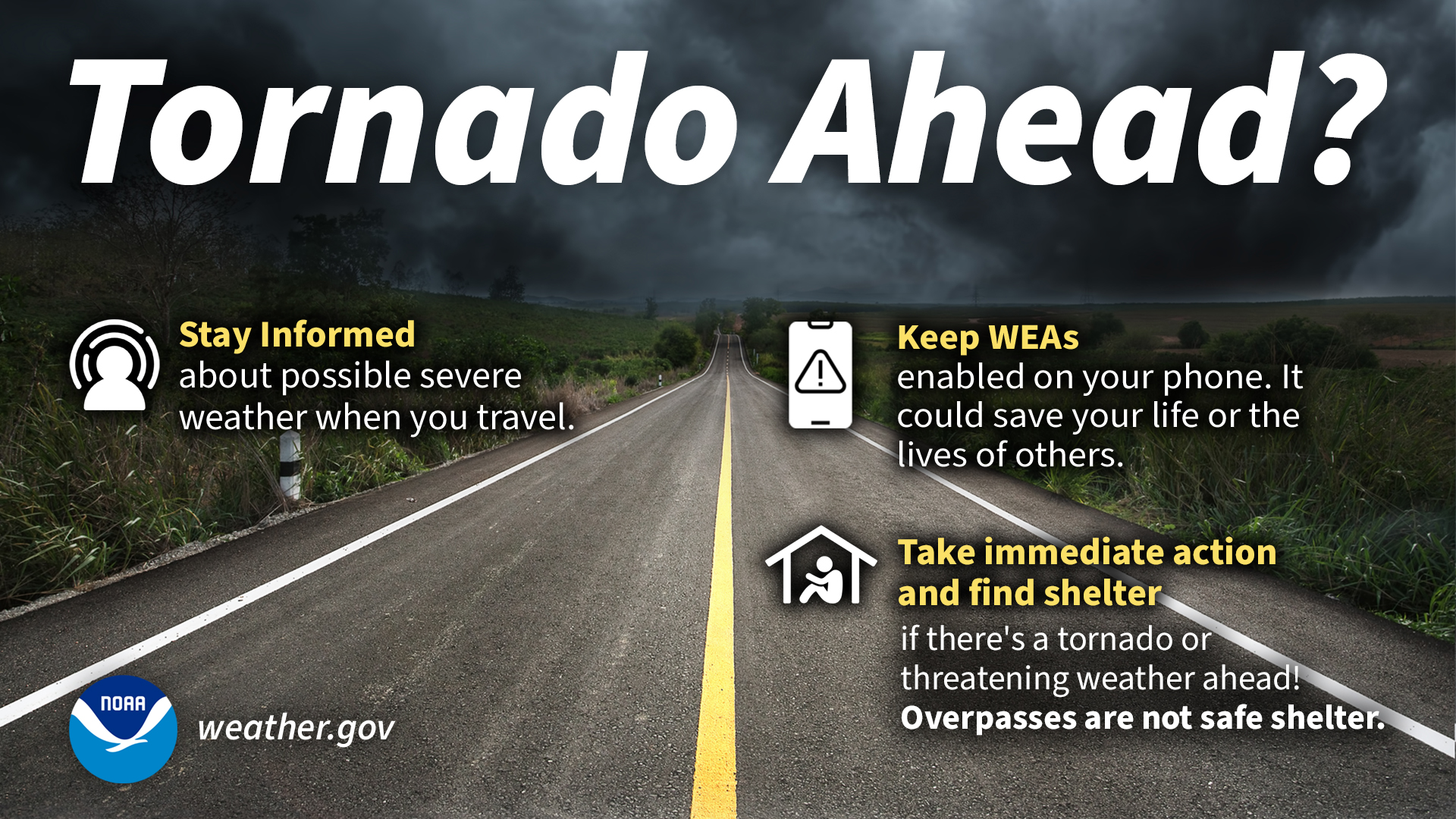
Facebook
Hey, Employers, Managers, Bosses & Supervisors!
Does your workplace have a designated tornado shelter? Does your workforce know what to do when severe weather threatens?
Learn about tornado safety plans at weather.gov or at osha.gov/tornado
X/Twitter
Hey, Employers, Managers, Bosses & Supervisors! Does your workplace have a designated tornado shelter? Does your workforce know what to do when severe weather threatens?
Learn about tornado safety plans at weather.gov or at osha.gov/tornado
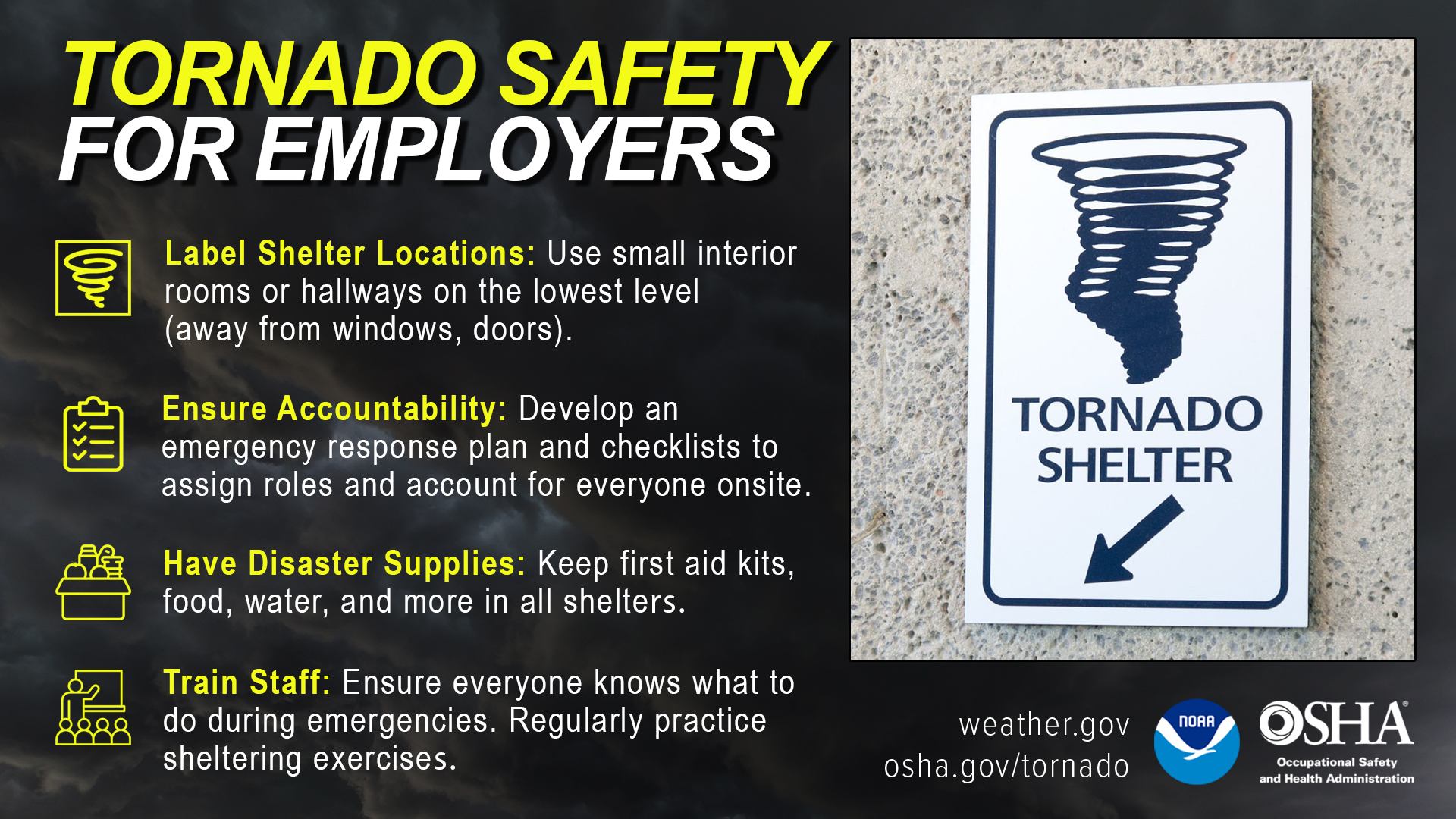
Facebook
Don’t wait until the day of the storm to begin protecting yourself. If the forecast calls for severe weather, begin preparing NOW. Stay Weather-Ready.
weather.gov/safety/tornado
Twitter
Don’t wait until the day of the storm to begin protecting yourself. If the forecast calls for severe weather, begin preparing NOW. Stay #WeatherReady.
weather.gov/safety/tornado
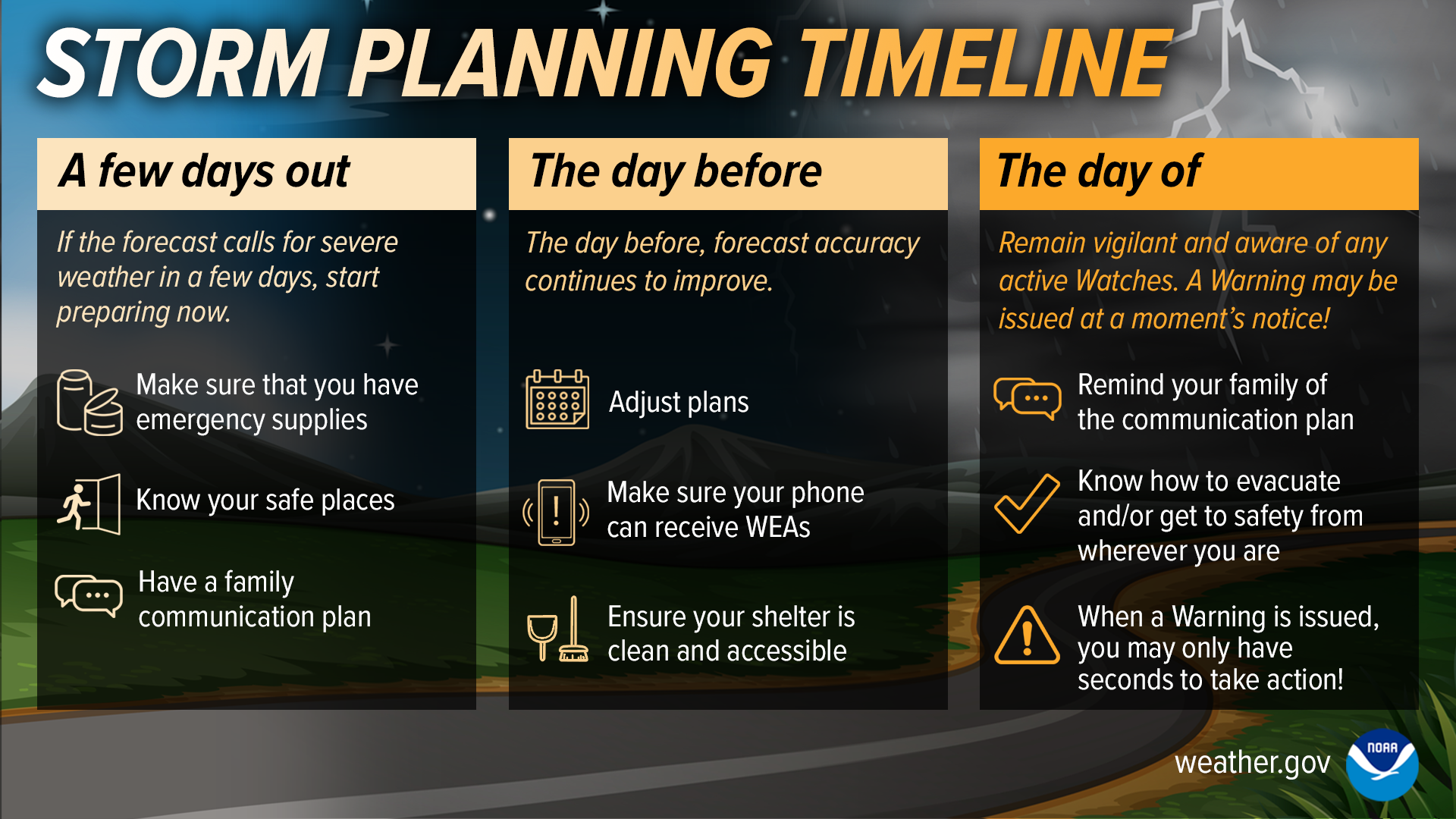
Facebook
Some people are especially vulnerable to weather hazards.
When a Tornado Warning is issued, the standard safety action is to immediately take shelter in a safe place. However, people with a lower-level of mobility, such as the elderly or disabled, may need to take action beforehand, such as when a Tornado Watch is issued.
Help them and others in your community prepare by helping them identify a safe space, practicing (and timing) tornado drills with them, and showing them how to receive Tornado Watches and Warnings.
weather.gov/safety/tornado
Twitter
Some people are especially vulnerable to the dangers of tornadoes.
Those with a lower level of mobility, such as the elderly or disabled, may need your help to prepare and stay safe. #WeatherReady weather.gov/safety/tornado
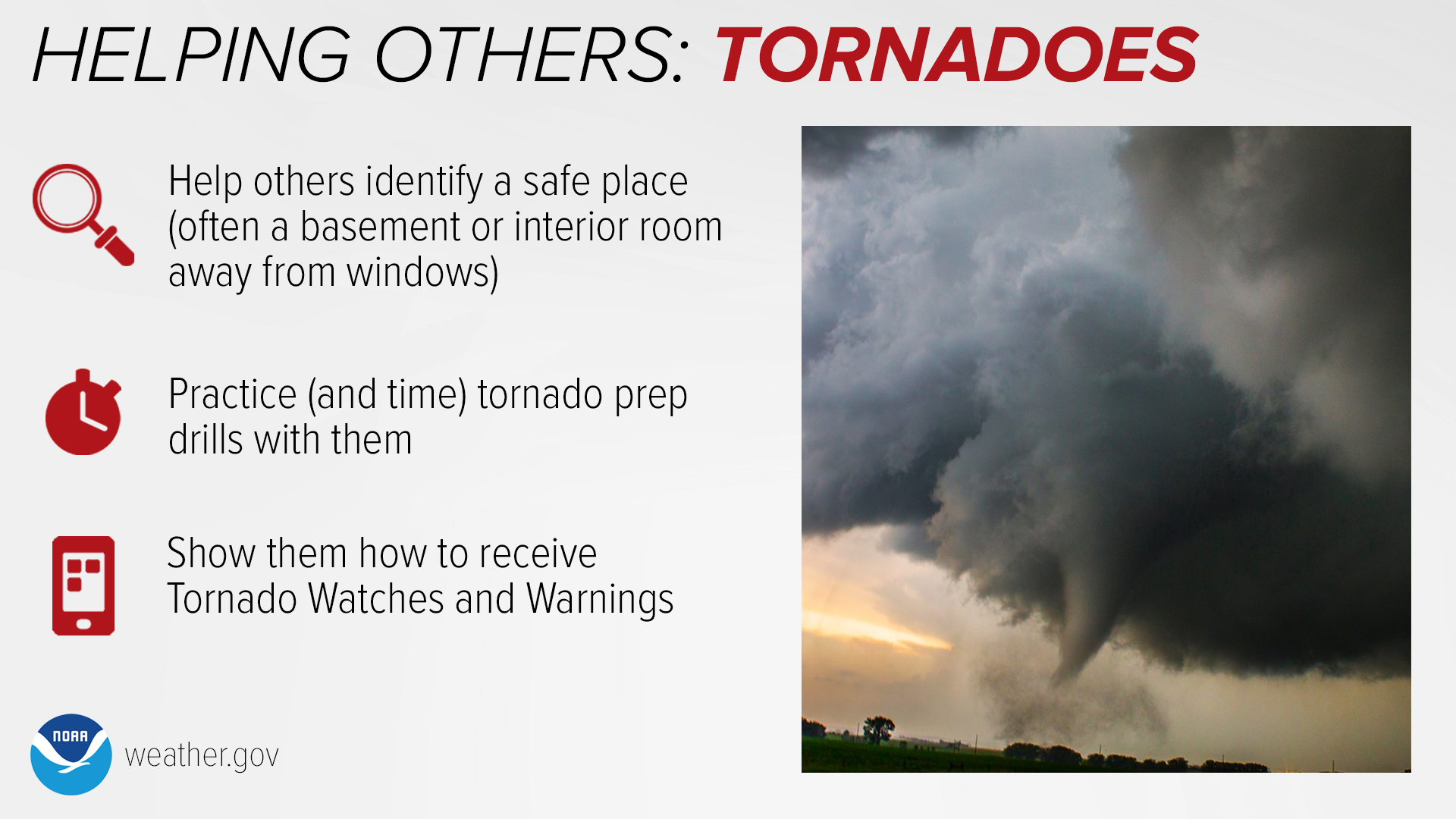
Facebook
Tornadoes can form in minutes, day or night. Stay Weather-Ready by having a way to receive weather alerts any time of day. If you receive a Tornado Warning, get to shelter immediately. weather.gov/safety/tornado
Twitter
Tornadoes can form in minutes, day or night. Stay #WeatherReady by having a way to receive weather alerts any time of day. If you receive a Tornado Warning, get to shelter immediately. weather.gov/safety/tornado

Facebook
A Tornado WATCH means Be Prepared.
A Tornado WARNING means Take Action!
weather.gov/safety/tornado-ww
Twitter
A Tornado WATCH means Be Prepared.
A Tornado WARNING means Take Action!
weather.gov/safety/tornado-ww #WeatherReady

Facebook
Tornadoes can be extremely dangerous. Safe places include storm shelters and basements — but if not available, an interior room without windows can also be protective. If you receive a tornado warning, take shelter immediately! weather.gov/safety/tornado
Twitter
Tornadoes can be extremely dangerous. Safe places include storm shelters and basements — but if not available, an interior room without windows can also be protective. If you receive a tornado warning, take shelter immediately! weather.gov/safety/tornado #WeatherReady
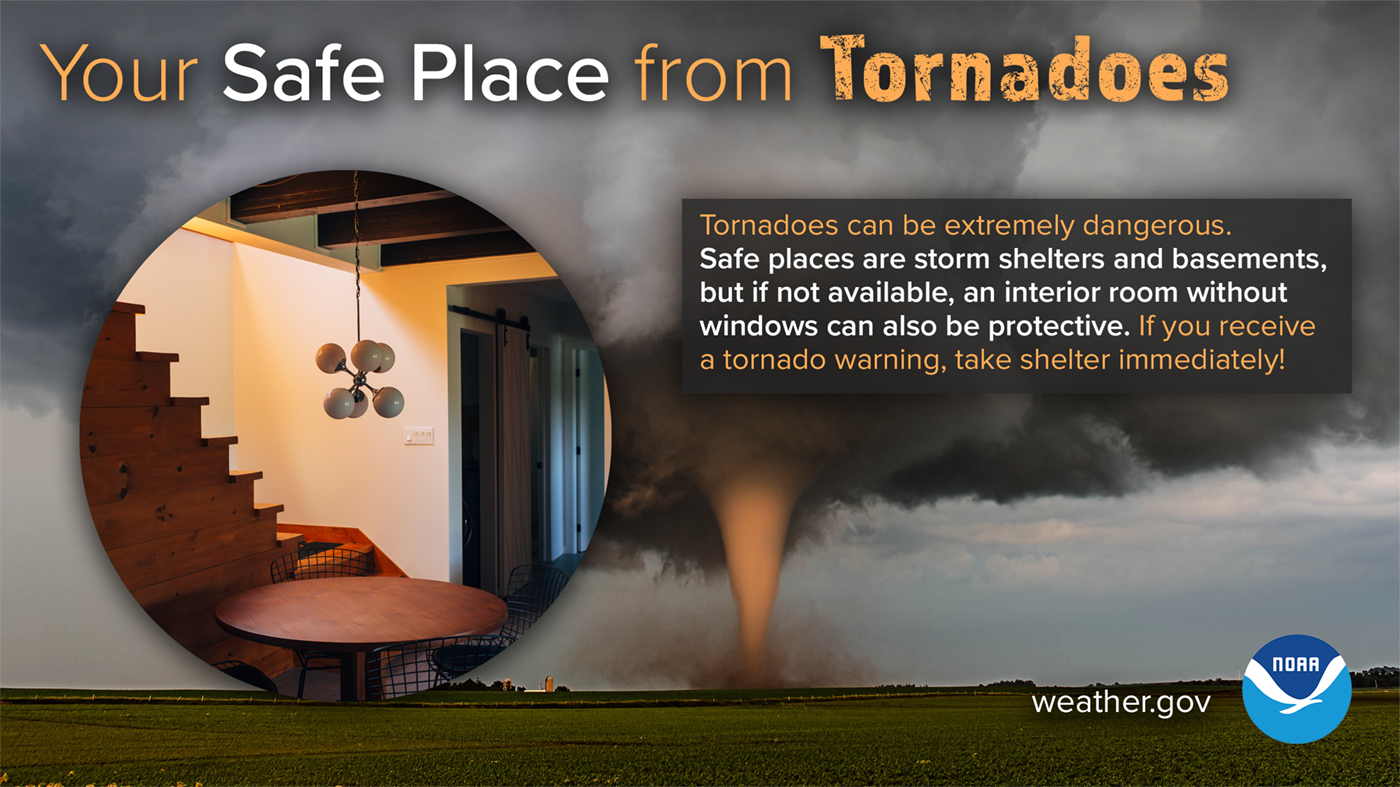
Facebook
What does being Weather-Ready look like? When it comes to tornadoes, it means knowing your ‘safe place’ and practicing going there well before severe weather arrives. Learn more tornado safety tips at weather.gov/safety/tornado
Twitter
What does being #WeatherReady look like? When it comes to tornadoes, it means knowing your ‘safe place’ and practicing going there well before severe weather arrives. Learn more tornado safety tips at weather.gov/safety/tornado

Facebook
Of all the many dangerous weather hazards, tornadoes are one of the most powerful and destructive. Although the details of their formation are still being researched, we do know the general steps. Watch this video for a quick science lesson. youtu.be/MMLRNW4UJOc
Twitter
Although the details of tornado formation are still being researched, we do know the general steps. Watch this video for a quick #science lesson. youtu.be/MMLRNW4UJOc
Facebook
You know to take shelter immediately if your area receives a Tornado Warning. But what makes a good shelter? Take the time now to figure out your options and make sure you’re Weather-Ready. weather.gov/safety/tornado
Twitter
You know to take shelter immediately if your area receives a Tornado Warning. But what makes a good shelter? Take the time now to figure out your options and make sure you’re #WeatherReady weather.gov/safety/tornado
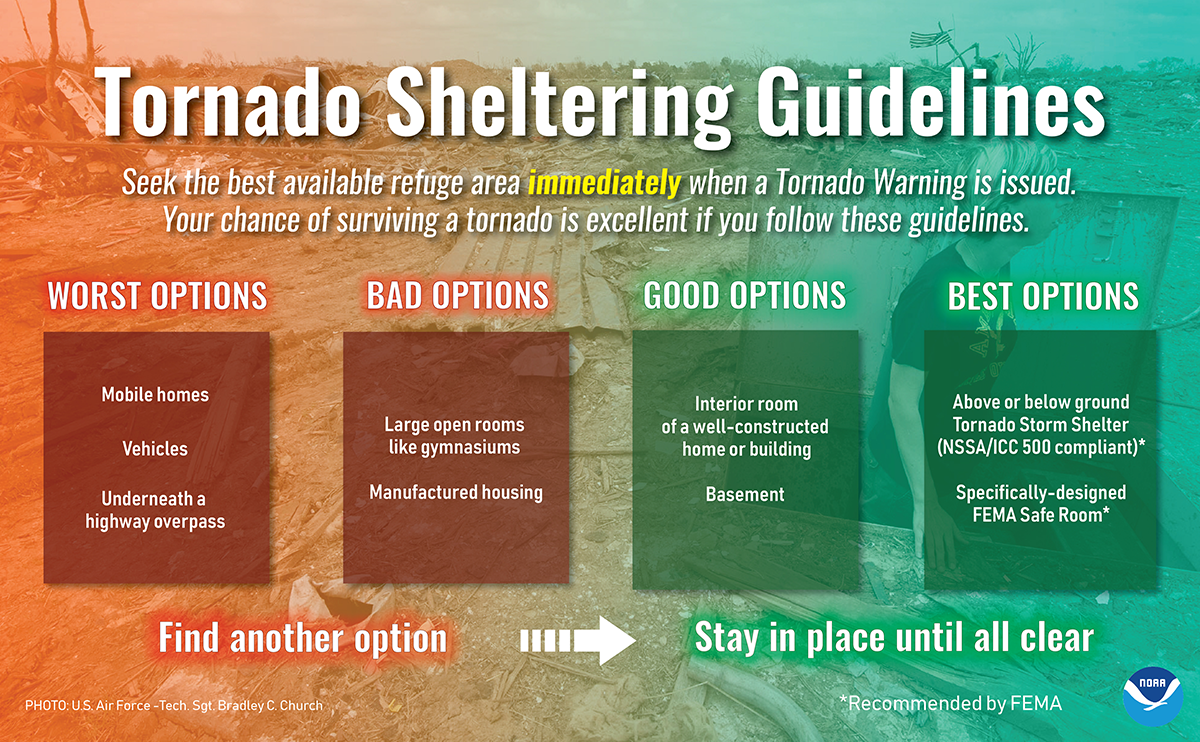
Facebook
Imagine you’re relaxing at home...when all of a sudden, a Tornado Warning comes through on your phone or NOAA Weather Radio. Where will you go to stay safe? weather.gov/safety/tornado
Twitter
Imagine you’re relaxing at home...when all of a sudden, a Tornado Warning comes through on your phone or NOAA Weather Radio. Where will you go to stay safe? #WeatherReady weather.gov/safety/tornado

Facebook
During a tornado, seeking refuge in a vehicle or under an overpass is NOT safe. If you are outside during a tornado warning, the best option is to drive to a designated shelter, basement, or safe room. weather.gov/safety/tornado
Twitter
During a tornado, seeking refuge in a vehicle or under an overpass is NOT safe. If you are outside during a tornado warning, the best option is to drive to a designated shelter, basement, or safe room. weather.gov/safety/tornado #WeatherReady

Facebook
Have you ever noticed the wording “THIS IS A PARTICULARLY DANGEROUS SITUATION” in severe weather watches? Here’s what it means.
Twitter
Have you ever noticed the wording “THIS IS A PARTICULARLY DANGEROUS SITUATION” in severe weather watches? Here’s what it means. #WeatherReady
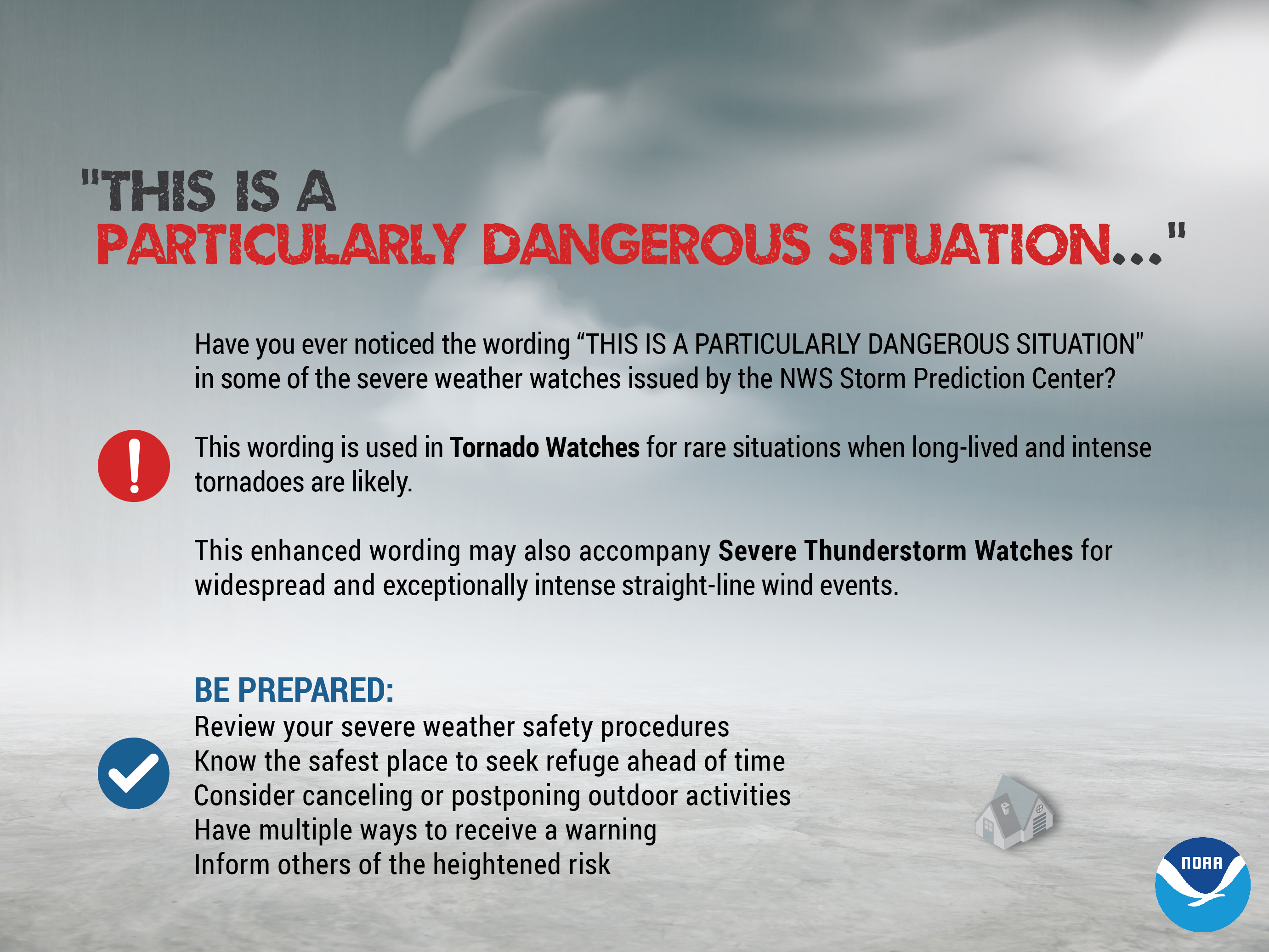
Facebook
Do you know the severe weather risk categories? See the severe weather outlooks issued by the Storm Prediction Center spc.noaa.gov/
Twitter
Know your risk for severe weather? See the Storm Prediction Center @NWSSPC spc.noaa.gov/ #WeatherReady

Facebook
Tornadoes, large hail, strong winds, flooding, and lightning are all hazards associated with severe weather. Severe weather has been reported in all 50 states, so no matter where you are, you need to be prepared! weather.gov/safety/thunderstorm
Twitter
Severe weather can occur anywhere. Wherever you are, be prepared! weather.gov/safety/thunderstorm #WeatherReady

Facebook
If your area is under a Tornado Warning, you may only have a few minutes to get to safety. Understand what to do if you’re in a tornado warning.
youtu.be/_5TiTfuvotc
Twitter
What should you do during a tornado warning? youtu.be/_5TiTfuvotc #WeatherReady
Facebook
If you are impacted by tornado damage, there are a few important things to remember. Listen to local officials, stay up-to-date on the forecast, contact loved ones (to let them know your status), and be mindful of debris (such as glass and nails) and downed power lines. Have a working radio with batteries available, and use flashlights instead of candles to avoid starting fires. weather.gov/safety/tornado-after
Twitter
If you are impacted by tornado damage, here are a few important things to remember. weather.gov/safety/tornado-after #WeatherReady

Facebook
Tornadoes occur at any time of day or night. The nighttime hours are particularly dangerous because most people are sleeping, and it can be nearly impossible to see an approaching tornado. Keep Wireless Emergency Alerts enabled on your cell phone so you will be alerted if you’re in the path of a tornado. ready.gov/alerts
Twitter
Keep Wireless Emergency Alerts enabled on your cell phone. Find out more at ready.gov/alerts #WeatherReady

Facebook
Tornadoes occur at any time of day or night. The nighttime hours are particularly dangerous because most people are sleeping, and it can be nearly impossible to see an approaching tornado. A NOAA Weather Radio can alarm you when a Tornado Warning is issued. Keep the radio near your bed. You may not like getting awakened, but it could save your life. weather.gov/nwr/
Twitter
Get severe weather warnings at night with a @NOAA Weather Radio. weather.gov/nwr/ #WeatherReady

Facebook
Make a severe weather plan before you need it! Your family may not be together when a disaster strikes, so it is important to plan in advance: how you will get to a safe place, how you will contact one another, how you will get back together, and what you will do in different situations. To find out how, visit ready.gov/make-a-plan
Twitter
How will you stay in touch during a disaster? Make a plan! ready.gov/make-a-plan #WeatherReady

Facebook
What’s a watch? What’s a warning? Learn the difference between a tornado watch and warning in this short video.
https://www.youtube.com/watch?v=x3V3HZBs1Y4
Twitter
Learn the difference between a tornado watch and warning. https://www.youtube.com/watch?v=x3V3HZBs1Y4 #SummerSafety